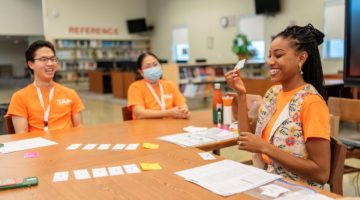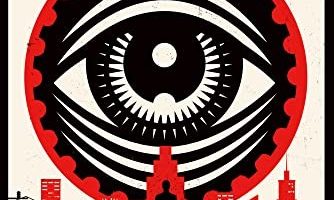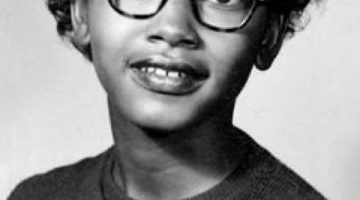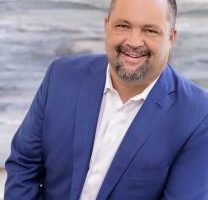 Special to South Florida Times
Special to South Florida Times
MIAMI — With thick beads of sweat running down his face, Addonis Parker grips a wet paint brush and drags it lightly over a brush stroke made by iconic late Overtown street artist Purvis Young almost three decades ago.
“All I’m doing is repeating,” explains Parker, the Liberty City-based artist hired to restore the eight murals that Young created in 1984 at the Culmer-Overtown Branch Library, at 350 N.W. 13th St., Miami. “I’ll do it light enough where you can still see his stroke come through. You want to keep as many strokes from the original artist as possible.”
But, Parker warns, as he continues to revive the fading figures on the eastern side of the library on Saturday, “you’ve got to be careful because there are images over images” in Young’s work. “You’ve got to take it slow,” he says. “I don’t believe in adding to what the original artist did.”
Recreational Design Construction commissioned Parker to restore the murals — a work that Young dubbed Everyday Life — as part of the Gibson Park renovation project. He hopes to complete the restoration in three months.
“I walked past here before the park renovations started,” Parker says, “and I wanted to be the guy selected to restore the murals.”
Young, who gained international acclaim for his expressionist renderings of inner city life, died in 2010 after suffering diabetic complications. Parker first met him at an art exhibition in the Miami arts district Wynwood a decade ago and kept in touch with him off and on. Parker says he really needs to connect with the soul of the man, his style and the message in his work to bring the murals back to life.
Before beginning the project a little more than a week ago, Parker explains, he studied the faded brush strokes and figures on the library’s exterior walls which have become weather-beaten and worn since they were last restored by Young in 1991.
Some of the murals also appear to be chipped by stray bullets which damaged the wall and lifted Young’s original painting off, Parker says.
Parker also researched archival photos and videos of Young working on the murals, which, he says, were very difficult to find.
“You want to understand how he thinks,” said Parker, who owns of the Art Forever Studios in Liberty City. “If I never understood the story Purvis was telling, I’d just be restoring expressionist art. I had to be a believer too.”
In documentary footage filmed more than two decades ago, Young talked about social and economic disparities and how life on the streets of Overtown is reflected in his work.
He also talked about the advice he would get from people concerning his expression of his inner-city experiences. While some wanted Young to mask these realities, others challenged him to continue exposing them as a way of rising above the daily struggles.
“You wake up and see the same thing every day in life,” Young said he would often hear. “Some tell me don't run from that stuff. Learn how to master that, man.”
Young preferred to express his opinions in his paintings. “I see the haves and the have-nots,” Young said in the footage. “A lot of things I know, I keep my mouth shut and paint.”
Parker says all of this is evident in Young’s murals at the Culmer-Overtown library.
“He recorded the misfortunes, the happiness and the togetherness” of the inner city, Parker says, and Young recorded “the stuff he didn’t have and that he wanted to see and it’s reflected in his work.
“You see liberation,” Parker says. “The squiggly marks are people of every nationality. It’s about strength and unity. He loved horses because they were free. Purvis was very, very into his art.”
So is Parker.
Born in central Florida, Parker, 39, grew up in Ohio and moved back to central Florida when he was 12. After graduating from high school, he moved to Atlanta, where he studied art history along with commercial and architectural design at Georgia State University and Morris Brown College.
A figurative and surrealist painter, Parker moved to Miami in 2001 and began meeting local artists through the African Heritage Cultural Art Center. He is hoping eventually to earn a master’s degree in commercial art from the University of Miami.
For now, Parker is busy with work. Besides restoring Young’s library murals in Overtown, he is putting the final touches on one of his own that he is painting at the Claude Pepper Park Community Center. He is also restoring a mural at a Metrorail station along U.S. Highway 1 and Northwest 27th Avenue.
“My grandfather used to say, ‘The more you know, the less you’ll starve,’” Parker says.
Earlier this year, Parker restored another mural that Young painted in 1986 at the Northside Metrorail station, 3150 NW 79th St., Miami. That experience, he says, also helped him develop an understanding of Young’s style, which is different from his own.
Young “was loose and had a free stroke,” Parker explains. “The colors signified what he believed in.”
For Young, he says, red signified emotion, orange signified energy, white signified purity, blue signified royalty, and black signified dominance. Those colors intricately combine and meld on Young’s concrete, yellow canvas at the Culmer-Overtown library, depicting scenes of urban stress and congestion in the inner city.
“I think he was the greatest African-American artist of the Southeast region,” Parker says. “I can never be him. I wish not to be him. My goal is to be the best I can be. If he were here, we’d be working together.”
Parker says like Young he strives to remain humble as he captures life in the inner-city on canvas.
“I think Liberty City and Overtown are beautiful,” Parker says. “They’re two sisters with a lot on their minds trying to make a difference.
Photo: Udonis Parker restoring Purvis Young mural.












No Comment